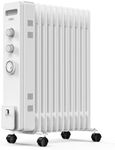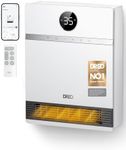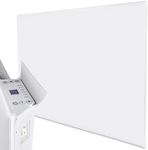Buying Guide for the Best Electric Radiators
Choosing the right electric radiator involves understanding your heating needs and the specific features that will best meet those needs. Electric radiators are a great option for efficient and flexible heating, but with so many options available, it's important to consider the key specifications that will impact performance, efficiency, and comfort. By understanding these specifications, you can make an informed decision that ensures your home is warm and cozy while also being energy-efficient.WattageWattage indicates the power output of the electric radiator and is crucial for determining how much heat it can produce. Higher wattage means more heat output, which is suitable for larger rooms or spaces with poor insulation. Typically, a radiator with a wattage of around 100 watts per square meter is recommended for standard rooms. For smaller rooms or well-insulated spaces, a lower wattage may suffice. Consider the size of the room and its insulation quality when choosing the wattage to ensure efficient heating without excessive energy consumption.
ThermostatA thermostat controls the temperature of the radiator, allowing you to maintain a consistent and comfortable room temperature. There are basic manual thermostats and more advanced programmable ones. Manual thermostats are simple to use but require you to adjust settings manually. Programmable thermostats offer more convenience by allowing you to set different temperatures for different times of the day. If you have a regular schedule, a programmable thermostat can help save energy by reducing heating when it's not needed.
Heating Element TypeThe heating element type affects how quickly and efficiently the radiator heats up. Common types include oil-filled, ceramic, and aluminum elements. Oil-filled radiators retain heat longer, making them efficient for continuous use. Ceramic elements heat up quickly and are good for rapid heating needs. Aluminum elements are lightweight and offer a balance between quick heating and heat retention. Consider how quickly you need the room to heat up and how long you want it to stay warm when choosing the heating element type.
Size and DesignThe size and design of the radiator can impact both its heating efficiency and how well it fits into your space. Larger radiators can heat bigger areas but may take up more space. Slimline designs are ideal for smaller rooms or where space is limited. Additionally, the design can affect the aesthetic appeal of the room. Consider the available space and the room's decor when selecting the size and design to ensure the radiator complements your home while providing adequate heating.
Energy EfficiencyEnergy efficiency is important for reducing energy consumption and lowering utility bills. Look for features like eco-modes, timers, and smart controls that help optimize energy use. Radiators with good energy efficiency ratings will use less electricity to produce the same amount of heat, making them more cost-effective in the long run. If you're concerned about energy costs or environmental impact, prioritize models with high energy efficiency ratings and features that allow for better control over energy usage.
Safety FeaturesSafety features are essential to prevent accidents and ensure safe operation, especially in homes with children or pets. Common safety features include overheat protection, which automatically turns off the radiator if it gets too hot, and tip-over switches that shut off the unit if it falls over. Some models also have cool-touch surfaces to prevent burns. Consider the safety features that are most important for your household to ensure peace of mind while using the radiator.
















